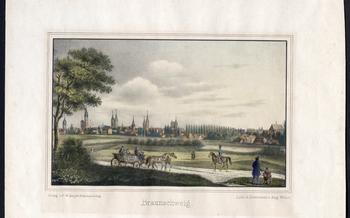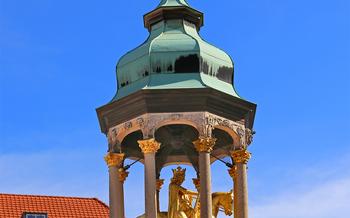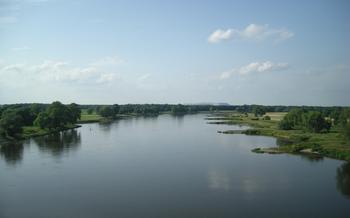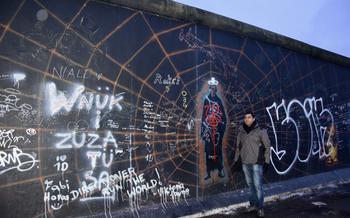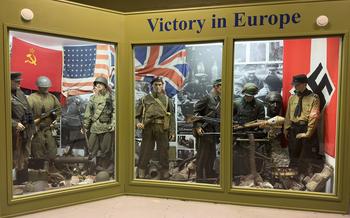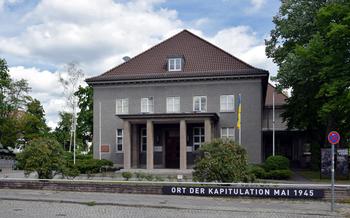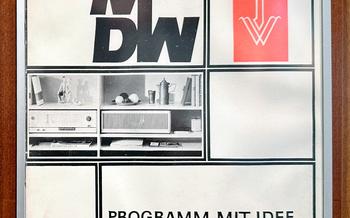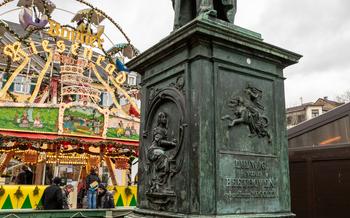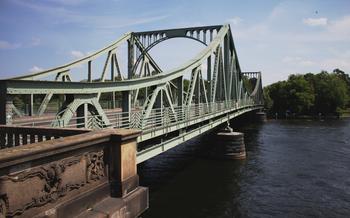
Marienborn Border Museum (approx. 1 hour drive)
- A Journey Through Time at the Marienborn Border Museum
- Immerse Yourself in the History of a Divided Germany
- Discover the Stories of Those Who Lived on the Edge
- Explore the Museum's Unique Setting
- Interactive Exhibits for an Engaging Experience
- Learn About the Peaceful Revolution and German Reunification
- Contemplate the Consequences of Division and Separation
- Appreciate the Museum's Commitment to Education and Remembrance
- Prepare for Your Visit to the Marienborn Border Museum
- Nearby Attractions and Points of Interest
- Savor the Local Cuisine and Culinary Delights
- Embrace the Rich Cultural Heritage of Magdeburg
- Plan Your Accommodation for a Comfortable Stay
- Explore Magdeburg's Shopping Scene and Local Treasures
- Insider Tip: Unveiling Magdeburg's Hidden Gems
A Journey Through Time at the Marienborn Border Museum
During the Cold War era, the Marienborn Border Museum stood as a silent witness to the division of Germany. Today, it invites visitors to step back in time and explore the complexities of life along the Iron Curtain. Through captivating exhibits, personal accounts, and interactive elements, the museum narrates the stories of division, escape attempts, and the relentless pursuit of border security.
Border guards, with their stern expressions and watchful eyes, once patrolled these grounds, enforcing strict regulations and facing moral dilemmas. Escapees, driven by a longing for freedom or the hope of reuniting with loved ones, risked their lives to cross the treacherous border, their stories a testament to the human spirit's resilience. Personal belongings and documents, preserved within the museum's walls, offer a poignant glimpse into the lives of those affected by the border's presence.
Interactive exhibits engage visitors, inviting them to decipher codes, solve puzzles, and virtually experience the challenges of crossing the border. The museum's unique location, situated directly on the former border, adds a layer of authenticity to the experience, allowing visitors to stand on the very ground where history unfolded.
Immerse Yourself in the History of a Divided Germany
During the Cold War, Germany found itself at the heart of the ideological struggle between East and West. The Marienborn Border Museum delves into this complex period, shedding light on the stark contrasts between life in the German Democratic Republic (GDR) and the Federal Republic of Germany (FRG).
The museum's exhibits showcase the realities of everyday life in a divided Germany, highlighting the differences in political systems, economic structures, and social norms. Visitors can explore the stringent border security measures implemented by the GDR, including watchtowers, fences, and armed patrols, and learn about the consequences faced by those who dared to cross the border illegally.
The Marienborn Border Museum serves as a poignant reminder of the Cold War's impact on Germany and its people. It offers a deeper understanding of the division that shaped the country's history and the significance of the Berlin Wall as a symbol of the Iron Curtain. Through its immersive exhibits and personal accounts, the museum invites visitors to reflect on the complexities of this period and its enduring legacy.
Discover the Stories of Those Who Lived on the Edge
Beyond the historical exhibits, the Marienborn Border Museum offers a deeply personal perspective on the lives of those who lived and worked along the border. Through firsthand accounts, personal artifacts, and oral histories, visitors gain a profound understanding of the human experiences that shaped this tumultuous era.
Border guards, who enforced the strict regulations and faced moral dilemmas, share their poignant stories. Visitors learn about the daring attempts of individuals who risked their lives to cross the border, seeking freedom or family reunification, and the consequences faced by those who were caught. Personal belongings and documents offer a glimpse into the lives of those affected by the border, revealing the sacrifices, hopes, and struggles they endured.
Oral histories from eyewitnesses and survivors bring history to life, enabling visitors to connect with the human stories behind the statistics and events. These powerful narratives shed light on the emotional toll, resilience, and determination of those who lived in the shadow of the Iron Curtain.
Explore the Museum's Unique Setting
The Marienborn Border Museum is strategically situated directly on the former border between East and West Germany, offering a captivating glimpse into the complexities of border life during the Cold War era. Ascend the observation tower for a panoramic vista of the surrounding landscape, allowing you to fully appreciate the impact of the border. Marvel at the preserved watchtowers, fences, and other remnants of the border fortifications, providing an authentic historical experience. Trace the path of the former border through the countryside, marked by informative signs and memorials, offering a deeper understanding of its significance.
Interactive Exhibits for an Engaging Experience
The Marienborn Border Museum elevates the visitor experience through its innovative use of interactive technologies. Immerse yourself in a virtual reality simulation, recreating the heart-pounding moments of attempting to cross the border. Utilize augmented reality to visualize the historical landscape and gain insights into specific events that unfolded along the border. Engage with multimedia presentations showcasing archival footage, photographs, and interviews, providing a comprehensive understanding of border life. Participate in hands-on activities that allow you to decipher codes, solve puzzles, and gain a deeper appreciation for the complexities of border security. These interactive elements bring the history of the border to life, creating a truly immersive and unforgettable experience.
Learn About the Peaceful Revolution and German Reunification
The Marienborn Border Museum also sheds light on the pivotal events that led to the peaceful revolution and German reunification. Visitors can explore the role of nonviolent resistance and the power of collective action in bringing about change. The fall of the Berlin Wall in 1989 marked a turning point in German history, and the museum delves into the significance of this event. Furthermore, it examines the challenges and triumphs of reunifying East and West Germany, creating a unified nation. The broader implications of German reunification for European politics and international relations are also explored, highlighting the museum's commitment to providing a comprehensive understanding of this transformative period.
Contemplate the Consequences of Division and Separation
The Marienborn Border Museum not only sheds light on the past but also invites visitors to contemplate the broader consequences of division and separation. The physical and ideological barriers erected during the Cold War had a profound impact on the lives of individuals, families, and entire communities.
Personal Struggles: The division of Germany left an emotional scar on the nation's psyche. Families were separated, and loved ones were torn apart, creating a sense of longing and loss that lasted for generations. The museum highlights the personal stories of those affected, capturing the heartbreak and resilience of individuals who lived through this tumultuous period.
Political Implications: The division of Germany was not merely a domestic issue; it had far-reaching political implications. The Cold War transformed Germany into a frontline state, with the East-West border becoming a symbol of the global ideological struggle. The museum explores the geopolitical consequences of the division, including the rise and fall of the Soviet Union and the impact on international relations.
Lessons Learned: The Marienborn Border Museum invites visitors to draw parallels between the division of Germany and other conflicts and divided regions around the world. It prompts reflection on the universal themes of freedom, unity, and the human cost of division. By understanding the past, we can gain insights into the challenges faced by divided societies today.
Memorialization: The museum serves as a memorial to the victims of the border regime. It honors their memory through exhibits, memorials, and commemorative events. Visitors are encouraged to pay tribute to those who lost their lives or suffered as a result of the division, ensuring that their stories are never forgotten.
Appreciate the Museum's Commitment to Education and Remembrance
The Marienborn Border Museum is dedicated to preserving the history of the border and promoting remembrance. The museum offers a variety of educational programs and workshops designed to help visitors understand the complexities of the border regime and its impact on the lives of those who lived along it. The museum also conducts research and documentation to ensure that the history of the border is not forgotten. In addition, the museum collaborates with other institutions to share knowledge and promote dialogue on border issues worldwide. By preserving historical sites and museums like the Marienborn Border Museum, we ensure that the lessons of the past are never forgotten and that future generations can learn from the mistakes of the past.
Prepare for Your Visit to the Marienborn Border Museum
Before embarking on your journey to the Marienborn Border Museum, it is essential to plan your visit to ensure a smooth and enriching experience.
Plan Your Trip:
-
Check the museum's website or contact them directly to obtain up-to-date information on opening hours, admission fees, and guided tour availability.
-
Plan your visit during the museum's regular operating hours, which may vary depending on the season or special events.
-
Purchase your tickets in advance online or at the museum's ticket counter to avoid queues and guarantee your entry.
Accessibility:
-
The museum strives to provide an inclusive environment for all visitors.
-
If you have any accessibility requirements, such as wheelchair access or sign language interpretation, please contact the museum in advance to make necessary arrangements.
Guided Tours:
-
Guided tours are available in various languages and offer a deeper insight into the museum's exhibits and the history of the border.
-
Pre-book your tour to secure your spot, especially if visiting during peak season or with a large group.
Photography:
-
Photography is generally permitted within the museum, but please be respectful of other visitors and avoid using flash or tripods that may obstruct their view.
-
For commercial photography or filming, please seek permission from the museum's administration.
Nearby Attractions and Points of Interest
Magdeburg offers a wealth of cultural and historical attractions beyond the Marienborn Border Museum. Explore the awe-inspiring Magdeburg Cathedral, a magnificent example of Gothic architecture that stands as a testament to the city's rich religious heritage. Immerse yourself in the tranquility of Elbauenpark, a sprawling green oasis featuring themed gardens, a cable car, and a variety of recreational activities for visitors of all ages. Stroll through the picturesque Herrenkrug Park, renowned for its stunning gardens, historic monuments, and serene atmosphere, providing a perfect escape from the hustle and bustle of city life. Delve into the maritime history of Magdeburg at the Waterway Museum, showcasing fascinating exhibits on shipbuilding, navigation, and the significance of the Elbe River in the region's development.
Savor the Local Cuisine and Culinary Delights
Magdeburg's culinary scene offers a delectable blend of traditional German dishes and modern culinary creations. Indulge in regional specialties such as "Pfälzer Saumagen," a savory stuffed pork stomach, or "Magdeburger Schnitzel," a crispy breaded pork cutlet. Quench your thirst with the region's renowned beers, including the popular "Magdeburger Zwickelbier," brewed according to centuries-old traditions. Explore local breweries and sample their diverse offerings, savoring the rich flavors and aromas of these handcrafted beverages. For a taste of fresh, local produce, visit the vibrant farmers' markets, where you can browse stalls laden with seasonal fruits, vegetables, artisanal cheeses, and homemade delicacies. Consider joining a culinary tour to discover the hidden gems of Magdeburg's food scene and learn about the city's culinary heritage from passionate local guides.
Embrace the Rich Cultural Heritage of Magdeburg
Magdeburg boasts a vibrant cultural scene that offers a diverse range of experiences for visitors. Immerse yourself in the world-class performances at the Theater Magdeburg, showcasing a captivating repertoire of plays, musicals, and dance productions. Indulge in the harmonious sounds of the Magdeburg Philharmonic Orchestra, renowned for its exceptional concerts and collaborations. Explore the Kunstmuseum Magdeburg, housing an impressive collection of modern and contemporary art, including works by renowned German artists. Participate in Magdeburg's vibrant cultural festivals, such as the "Magdeburg Summer Festival" and the "Magdeburg Christmas Market," celebrating the city's rich traditions and festive spirit.
Plan Your Accommodation for a Comfortable Stay
To ensure a comfortable and memorable stay in Magdeburg, careful planning of your accommodation is essential. Whether you prefer the convenience of modern hotels, the charm of historic guesthouses, or the authenticity of bed and breakfasts, Magdeburg offers a diverse range of options to suit every taste and budget.
For those seeking a hassle-free experience, online booking platforms provide a convenient way to compare prices, read reviews, and secure your accommodation in advance. Additionally, consider hotels located near the Marienborn Border Museum to minimize travel time and maximize your exploration opportunities.
If you desire a unique and immersive experience, explore Magdeburg's charming guesthouses and bed and breakfasts. These accommodations often offer a glimpse into the city's rich history and culture, providing a more personalized and authentic stay.
No matter your choice, ensure that your accommodation aligns with your preferences and budget to create a comfortable base for your exploration of Magdeburg and its captivating attractions.
Explore Magdeburg's Shopping Scene and Local Treasures
Magdeburg offers a vibrant and diverse shopping experience, catering to every taste and budget. Stroll along Breite Weg, the city's main shopping street, lined with international brands, charming boutiques, and specialty stores. Discover unique souvenirs and handmade crafts at the bustling local markets, where vendors showcase their wares amidst a lively atmosphere. For a convenient and modern shopping experience, visit one of Magdeburg's shopping centers, such as the "Allee-Center Magdeburg," which houses a wide range of retail outlets under one roof. If you're passionate about vintage and antiques, delve into the city's hidden gems – small shops and boutiques that offer a treasure trove of unique items, from retro clothing to antique furniture. Whether you're searching for the latest fashion trends, local delicacies, or one-of-a-kind souvenirs, Magdeburg's shopping scene promises an unforgettable experience.
Insider Tip: Unveiling Magdeburg's Hidden Gems
Magdeburg boasts an array of hidden gems waiting to be discovered by curious travelers. For an off-the-beaten-path experience, embark on a guided tour of the city's historic canals. Cruise along the tranquil waters, passing under ancient bridges and admiring the charming waterfront architecture. Alternatively, delve into Magdeburg's industrial heritage at the Technikmuseum Magdeburg. This fascinating museum houses an impressive collection of vintage machinery, engines, and vehicles, providing a glimpse into the city's rich history of innovation and engineering. Whether you seek unique cultural experiences or captivating historical insights, Magdeburg's hidden gems offer a rewarding adventure for those willing to explore beyond the usual tourist trail.
